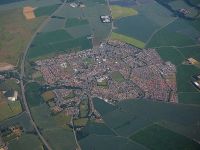Tranent /trəˈnɛnt/ is a town in East Lothian (formerly Haddingtonshire), in the south-east of Scotland. It lies beside the A1 road,the A1 runs through the parish splitting the parish from its associated villages and hamlets namely Meadowmill and the port of the parish Cockenzie.The original main post road ran straight through the town until the new A1 was built.10 miles (16 km) east of Edinburgh. It is one of the oldest towns in East Lothian, and built on a gentle slope, about 90 metres (300 ft) above sea level. The population of the town is approximately 12,140, an increase of over 4,000 since 2001. Tranent was formerly a major mining town, but now serves as a commuter town for Edinburgh.
History
The name is thought to be of Brythonic origin, possibly containing the elements Tre and Nant, meaning town over the stream Travernant.
Tranent was once an important mining town, and coal was first worked there in the thirteenth century by the monks of Newbattle Abbey who mined a nearby 2.5m / 7 ft thick coal deposit called the "Great Seam". The town possesses the oldest coal-mining charter (1202–1218) in Great Britain, and the history of coal mining in Scotland is mirrored in the history of the coal heughs, mines and pits of Tranent. Tranent is now a commuter town supporting the south-east of Scotland and, more specifically, Edinburgh.
The Massacre of Tranent took place in 1797, when local people were killed by soldiers after a protest against conscription into the county militia under the Militia Act of 1797. One of the 12 victims, Jackie Crookston, is depicted on the memorial that commemorates the dead in Tranent's Civic Square.
In connection with the annual commemoration of the Battle of Prestonpans (originally called the Battle of Gladsmuir, and then renamed the Battle of Tranent, before many decades later being renamed the Battle of Prestonpans) there are plans to recreate a small portion of the Tranent to Cockenzie Waggonway which dates back to 1722.
There
